
Pacific Conservation Biology
Volume 28 Number 1 2022
PCv28n1_OBTribute to Kenneth (Ken) James Wallace: exceptional conservation reserve manager who integrated theory into practical conservation management (9 August 1950–13 October 2021)
We conducted a review of the published literature on the ecological impacts of rodent eradications conducted on Australian and New Zealand Islands. Reporting posteradication results for either Australia or New Zealand is minimal and has not increased over the past 50 years, despite increased awareness of the problem of under-reporting.
PC20091Researcher disillusionment and ungoverned damage to Becher Point Wetlands, Western Australia
Researcher disillusionment, angry mobs and four-wheel-drives damage the sandy headland at Becher Point, in Western Australia.
PC20088Variation in feral cat density between two large adjacent islands in Australia
 , Tiwi Land Rangers, Matthew W. Rees, Danielle Stokeld, Anna C. Miller, Graeme R. Gillespie and Brett P. Murphy
, Tiwi Land Rangers, Matthew W. Rees, Danielle Stokeld, Anna C. Miller, Graeme R. Gillespie and Brett P. Murphy
Despite contributing to the ongoing collapse of native mammal populations across northern Australian savannas, we have limited understanding of the ecological constraints of feral cat population density in this system. This study investigated cat density across Melville and Bathurst Islands, two large islands in Australia’s monsoon tropics, and demonstrated large variation in cat density between these adjacent islands. Management that enhances understorey vegetation density, through feral herbivore control, as well as fire management, could help mitigate the impact of feral cats.
PC20088 Abstract | PC20088 Full Text | PC20088PDF (568 KB) Open Access Article
We aimed to improve camera trap performance for wildlife detection. Swift 3C wide-angle camera traps increased detections by >100% when compared with Reconyx PC900/HC600 camera traps. The Swift’s wider detection angle and increased sensor sensitivity contributed to these results. Periodically repositioning cameras within sites did not improve detections except for some species.
PC20076 Abstract | PC20076 Full Text | PC20076PDF (1.9 MB) | PC20076Supplementary Material (144 KB) Open Access Article
We generate the largest DNA barcoding assessment of an insular vertebrate fauna, composed of 601 CO1 sequences representing ~94% (100 species) of lizards of the New Caledonian biodiversity hotspot. Using model-based phylogenetics, we show that CO1 can delimit and discover described and cryptic diversity, which can be misidentified and threatened.
This study investigates the distribution, abundance and foraging ecology of Caspian Terns during 5 months of their non-breeding season in the Ramsar-listed Peel-Harvey Estuary, south-western Australia. Direct observation was used to identify important foraging areas and a night roost site between October 2018 and March 2019. These preliminary investigations highlight the importance of this estuarine system for feeding and roosting Caspian Terns during non-breeding periods and provide baseline information for further research of this tern population and towards evaluating their use as bioindicators of Peel-Harvey Estuary.
PC20082 Abstract | PC20082 Full Text | PC20082PDF (1.2 MB) | PC20082Corrigendum (34 KB) | PC20082Supplementary Material (197 KB) Open Access Article
South-east Asia produces the most palm oil but is threatened by climate change. This paper describes an eastern longitudinal trend of increasingly suitable future climate for oil palm. Vietnam may become more suitable than Thailand. Comparisons with Africa and South America are made. However, the environmental consequences of novel plantations take priority.
PC20097Using experimental trials to improve translocation protocols for a cryptic, endangered passerine
 , Rebecca L. Boulton, Luke Ireland, Thomas J. Hunt, Simon J. Verdon, Liberty G. M. Olds, Chris Hedger and Rohan H. Clarke
, Rebecca L. Boulton, Luke Ireland, Thomas J. Hunt, Simon J. Verdon, Liberty G. M. Olds, Chris Hedger and Rohan H. Clarke
We report here results from the first trial conservation translocation of the endangered mallee emu-wren. Releases were structured within an adaptive experimental framework allowing key management insights to be gained, despite the reintroduced population not persisting. Spring releases should be prioritised for future releases.
PC20097 Abstract | PC20097 Full Text | PC20097PDF (2.1 MB) | PC20097Supplementary Material (21 KB) Open Access Article
Whale sharks, echeneids (remoras and sharksuckers) and a parasitic or commensal copepod share a unique three-way symbiosis. We explore these associations in a unique location in the Maldives and provide photographs and video to help unravel these relationships.
PC20043 Abstract | PC20043 Full Text | PC20043PDF (409 KB) | PC20043Supplementary Material (31.1 MB) Open Access Article
The Philippine mouse deer (Tragulus nigricans) is an endangered ungulate species, endemic to western Philippines. Despite its conservation importance, it has received little attention from local authorities and conservation biologists. Here we provide our preliminary report on the species’ distribution, population status, and conservation status.
We provide the first estimates of sea turtle density in Papua New Guinea from two locations around Mussau Island. We advocate that the low cost, in-water distance sampling method we utilised could form the basis for a national sea turtle monitoring system.
Thirty juvenile large forest bats (Vespadelus darlingtoni) were found dead in a plywood bat box. This is the first example in Australia of an overheating event in a bat box resulting in multiple mortalities. It confirms that extreme heat in poorly insulated bat boxes can result in acute hyperthermia.
PC20082_COCorrigendum to: Distribution and foraging by non-breeding Caspian Terns on a large temperate estuary of south-western Australia – preliminary investigations
PC20082_CO Abstract | PC20082_COPDF (34 KB) Open Access Article



